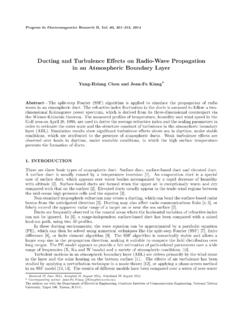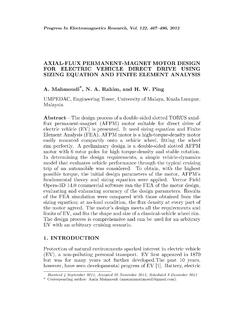Transcription of A PLANAR FOCUSING ANTENNA DESIGN USING QUASI …
1 Progress In Electromagnetics Research M, Vol. 13, 261 273, 2010A PLANAR FOCUSING ANTENNA DESIGN USINGQUASI-CONFORMAL MAPPINGZ. L. Mei ,J. Bai, and T. M. NiuSchool of Information Science and EngineeringLanzhou UniversityLanzhou 730000, ChinaT. J. CuiState Key Laboratory of Millimeter WavesDepartment of Radio EngineeringSoutheast UniversityNanjing 210096, ChinaAbstract We propose a PLANAR FOCUSING ANTENNA DESIGN , whichhas the same performance as its parabolic counterparts and can berealized USING PEC-backed gradient index dielectrics. In this DESIGN , QUASI -conformal transformation optics is first utilized to transform aparabolic surface into a PLANAR one, then the anisotropy factor of theresultant material is minimized, and the material is approximatelytreated as isotropic.
2 Examples with realizable material parameters aregiven, and the simulation results validate the DESIGN . The proposedmethod could be used to DESIGN PLANAR FOCUSING antennas with highdirectivity and similar devices. The idea can also be applied to newdevice designs in optics INTRODUCTIONIn 2006, Pendry and his coworkers theoretically designed an invisibilitycloak [1], which was soon verified experimentally by Smith et the microwave regime [2]. Their success has aroused greatinterests, and the method, transformation optics, coupled with theemerging metamaterial technology, has been intensively exploredin various designs such as cloaks [3 13], perfect lenses [14 16],Corresponding author: Z.
3 L. Mei Also with State Key Laboratory of Millimeter Waves, Department of Radio EngineeringSoutheast University, Nanjing 210096, et [17, 18], and other novel devices [19 21]. Being anindispensable part in telecommunication systems, many new types ofantennas have also been proposed based on this powerful tool [22 29].An awkward situation with transformation optics is that theresulting materials are, in most cases, inhomogeneous and anisotropic,and may have singular-valued material parameters [30, 31], whichseverely hinders the practical implementation. To deal with thisproblem, one straight-forward way is to limit the polarization ofthe incident wave and reduce the number of material parameters inMaxwell s equations.
4 Simplified material parameters are also proposedbased on the dispersion equation in anisotropic materials [2, 4].Another important method based on functional theory is to optimizethe transformation function so that only inhomogeneous and isotropicparameters can be achieved [5]. Under this circumstance, the resultingtransformation function is called QUASI -conformal mapping, which ismore general than classical conformal mapping. As an example, carpetcloaks working at the microwave and optical frequencies have beensuccessfully verified by experiments [6 8, 13]. Very recently, QUASI -conformal mapping transformation optics has also been utilized toflatten the traditional Luneburg lens, and satisfactory results arereported [32].
5 In this work, we make use of the transformation optics based onquasi-conformal mapping to DESIGN a directive and PLANAR focusingantenna, which has similar performance as a parabolic dish andcan be realized USING PEC-backed gradient-index materials. Thesegradient-index materials can be easily implemented with either non-resonant metamaterials or nonmagnetic dielectrics based on theeffective medium theory [6, 33]. Thus the ANTENNA is broadband innature and could be scaled down to optical frequencies. We believe thatthe proposed method and designed ANTENNA have wide applications inthe communication sectors and the DESIGN of solar THEORETICAL ANALYSISF igure 1 shows the virtual (a) and physical (b) spaces concernedwith the ANTENNA DESIGN , which is the basis for the transformationoptics method.
6 In the virtual space, the curved boundary representsa two-dimensional (2D) parabolic dish, which can be expressed as6y= (x 2)2 1. The aperture of the dish is 2 meters, and thefocal distance is m. The ANTENNA is fed by a 2D point source at thefocal point. It is obvious that the radiated fields will be reflectedby the dish and generally propagate along the vertical direction,and the device can have a high directivity. The region bounded byProgress In Electromagnetics Research M, Vol. 13, 2010263(a)(b)Figure mapping between the (a) virtual and (b)physical spaces. The green (horizontal) and red (vertical) lines showthe corresponding mapping between such two rectangle and parabolic curve, including the point source, is thesolution domain in the virtual space.
7 USING a deliberately designedcoordinate transformation, the solution domain is transformed intoa rectangular region in the physical space. Note that only thebottom boundary is compressed to flatten the curved segment (slippingboundary condition), and other boundaries are unchanged. From thetheory of transformation optics, we know that the resultant device, aPEC-backed metamaterial with the rectangular shape, will have thesame electrical performance as the original parabolic dish (outside therectangular region).Generally speaking, the resulting materials in the rectangularregion of the physical space are inhomogeneous and anisotropic, andthe electric permittivity tensor is given by =A AT/det(A)(1)in whichAis the Jacobian matrix between the two spaces [30, 31].
8 The same formula holds for the magnetic permeability tensor. Similarresults have been obtained by Kong et al. in the PLANAR antenna264 Mei et [26]. We note that for the given virtual and physicalspaces, there exist infinite number of transformations that can realizethe corresponding mapping, among which some can be expressedanalytically, while others can only be calculated numerically [1, 19].However, if we optimize the transformation function between the twospaces, we can then minimize the anisotropy of the metamaterial andtreat it as an isotropic one. As a consequence, the metamaterial iseasily realizable.
9 This is the major difference between the presentwork and that in [26].Suppose that we are analyzing the TE mode (Electric field normalto the transformation plane. TM results can be obtained USING theprinciple of duality), then the material parameters in Eq. (1) can befurther written as = 1/det(A), =AAT/det(A)(2)whereA, in this 2D situation, is given byA=( x x y y ).(3)Note that the virtual space is supposed to be a vacuum with = = Eqs. (2), it is easy to see that the anisotropy goes to thepermeability tensor. Since this is a symmetric quantity, it can beeasily diagonalized in the principal system, , = ( T, L), with T L= 1.
10 And the following anisotropy factor for the permeabilitytensor can be defined [5], which is = max( T/ L, L/ T).(4) USING the basic knowledge of linear algebra, it is not difficult to getthe following formula + 1/ = Tr(g)/ det(g),(5)wheregis the metric tensor andg= can be minimized in the entire solution domain, then theanisotropy can be minimized at the same time. And this is achievedby minimizing the Modified-Liao functional [34] = Tr(g)2det(g)d d .(6)Without going further into the technical detail, we borrow theresults given by [5] that the minimal for this functional occursat the QUASI -conformal map, which can be numerically calculatedusing grid generation techniques or through solving the Laplace sProgress In Electromagnetics Research M, Vol.






